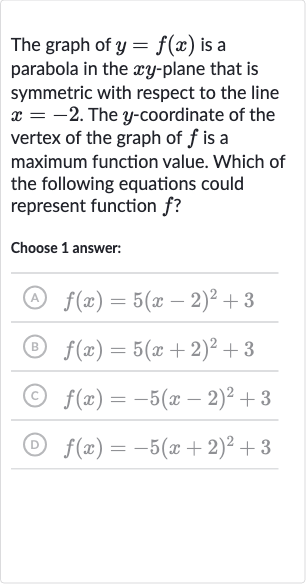AI tutor
Full solution
Q. The graph of is a parabola in the -plane that is symmetric with respect to the line . The -coordinate of the vertex of the graph of is a maximum function value. Which of the following equations could represent function ?Choose answer:(A) (B) (C) (D)
- Identify Parabola Form: Identify the general form of a parabola with its vertex at the point . The general form of a parabola is given by , where is the vertex of the parabola. If the parabola opens upwards, is positive, and if it opens downwards, is negative. Since the y-coordinate of the vertex is a maximum, the parabola opens downwards, which means should be negative.
- Determine Symmetry Line: Determine the value of from the symmetry line.The line of symmetry of the parabola is given by . Since the parabola is symmetric with respect to the line , the value of is .
- Eliminate Incorrect Options: Eliminate the options that do not have the correct vertex form with .Option (A) has , which does not match the required line of symmetry .Option (B) has , which matches the required line of symmetry.Option (C) has , which does not match the required line of symmetry .Option (D) has , which matches the required line of symmetry.
- Identify Parabola Direction: Identify the correct option based on the direction of the parabola.Since the -coordinate of the vertex is a maximum, the parabola must open downwards, which means should be negative. This eliminates option (B) because it has a positive value.
- Choose Correct Answer: Choose the correct answer from the remaining options.Option (D) is the only remaining option that satisfies both conditions: it has the correct line of symmetry () and the correct direction of the parabola ( is negative).
More problems from Compare linear and exponential growth
QuestionGet tutor help
QuestionGet tutor help
QuestionGet tutor help
QuestionGet tutor help
QuestionGet tutor help
QuestionGet tutor help
QuestionGet tutor help

